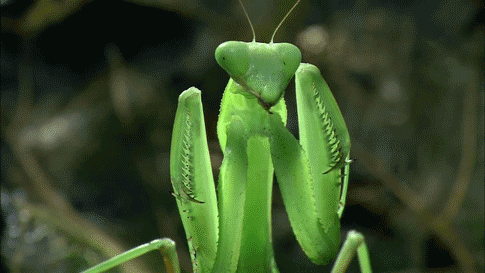Them there eyes
Aug 23, 2020 22:48:38 #
Folks may remember the large Chinese mantis (Tenodera sinensis) that I had shown a couple weeks ago. She stayed with me for several days for more pictures. Here I had fun photographing her murderous but lovely eyes.
In the daytime, a mantis and many other insects will show a distinctive “pupil” in each eye. This dark spot is called the pseudopupil, and it is really just an optical effect of compound eyes.
 Mantis eyes by day by Mark Sturtevant, on Flickr
Mantis eyes by day by Mark Sturtevant, on Flickr
Describing how this works is challenging, but here goes. Think of a compound eye as a bundle of tiny fiber optic tubes, where each tube is called an ommatidia. Each of these tubes / ommatidia has a lens, reflective pigment cells, and deep inside are light absorbing retina cells. Light that does not go straight down the center of an ommatidium will be reflected by the pigment cells, but light that does go straight down is efficiently absorbed by the retina cells. So the pseudopupil is merely the place where the ommatidia are pointing right at you, the observer, and you are seeing that those ommatidia are not reflecting light in your direction. So those ommatidia look pretty much black.
But the location of the pseudopupil is relative to the observer. When the mantis turns its head, the ommatidia that were facing you are turned away, and you see light reflected from them. Meanwhile new ommatidia swing into line to point right at you, and those are seen to turn black because you don't see much light reflected from them. The weird effect that results is that the pseudopupils are always pointing right at you no matter how the mantis turns its head.
 Mantis eyes by day by Mark Sturtevant, on Flickr
Mantis eyes by day by Mark Sturtevant, on Flickr
But at night, all of this changes and it can be startling to see if you are not used to it. At night the reflective pigment cells migrate away, and now each ommatidium shows much more of their light absorbing pigment cells. This is to better absorb light when it is dark. But to the observer, the eyes turn black. The next morning, the pigment cells migrate back to the surface, and the eyes again are much more reflective of light.
 Mantis eyes by night by Mark Sturtevant, on Flickr
Mantis eyes by night by Mark Sturtevant, on Flickr
So… Mild-Mannered Mantis by Day…
 Mild-mannered mantis by day... by Mark Sturtevant, on Flickr
Mild-mannered mantis by day... by Mark Sturtevant, on Flickr
By Night!
Finally, here is a gif animation shows the movement of the pseudo pupils described above. I should say this is not mine, but is available on 'gif' web sites.
In the daytime, a mantis and many other insects will show a distinctive “pupil” in each eye. This dark spot is called the pseudopupil, and it is really just an optical effect of compound eyes.
 Mantis eyes by day by Mark Sturtevant, on Flickr
Mantis eyes by day by Mark Sturtevant, on FlickrDescribing how this works is challenging, but here goes. Think of a compound eye as a bundle of tiny fiber optic tubes, where each tube is called an ommatidia. Each of these tubes / ommatidia has a lens, reflective pigment cells, and deep inside are light absorbing retina cells. Light that does not go straight down the center of an ommatidium will be reflected by the pigment cells, but light that does go straight down is efficiently absorbed by the retina cells. So the pseudopupil is merely the place where the ommatidia are pointing right at you, the observer, and you are seeing that those ommatidia are not reflecting light in your direction. So those ommatidia look pretty much black.
But the location of the pseudopupil is relative to the observer. When the mantis turns its head, the ommatidia that were facing you are turned away, and you see light reflected from them. Meanwhile new ommatidia swing into line to point right at you, and those are seen to turn black because you don't see much light reflected from them. The weird effect that results is that the pseudopupils are always pointing right at you no matter how the mantis turns its head.
 Mantis eyes by day by Mark Sturtevant, on Flickr
Mantis eyes by day by Mark Sturtevant, on FlickrBut at night, all of this changes and it can be startling to see if you are not used to it. At night the reflective pigment cells migrate away, and now each ommatidium shows much more of their light absorbing pigment cells. This is to better absorb light when it is dark. But to the observer, the eyes turn black. The next morning, the pigment cells migrate back to the surface, and the eyes again are much more reflective of light.
 Mantis eyes by night by Mark Sturtevant, on Flickr
Mantis eyes by night by Mark Sturtevant, on FlickrSo… Mild-Mannered Mantis by Day…
 Mild-mannered mantis by day... by Mark Sturtevant, on Flickr
Mild-mannered mantis by day... by Mark Sturtevant, on FlickrBy Night!
Finally, here is a gif animation shows the movement of the pseudo pupils described above. I should say this is not mine, but is available on 'gif' web sites.

Aug 23, 2020 22:52:51 #
Aug 23, 2020 23:16:50 #
Aug 23, 2020 23:42:27 #
Aug 23, 2020 23:44:04 #
These do look like creatures from outer space. I usually have a lot by my house every summer but don't know this year as I haven't been able to get out.
Aug 23, 2020 23:51:15 #
i have seen that but never got around to shooting one t night.now i want to :-)
Aug 24, 2020 00:23:00 #
Hi Mark. Loved the beautiful eyes, indeed! May I ask what combination of lens/magnification did you use to achieve such sharp, magnified closeups, especially in the 3rd an 4th (collage) photos? I'm practicing to improve my own technique. Thanks for your helpful advice.
NMY
NMY
Aug 24, 2020 00:56:57 #
Thank you everybody!
You can see the basic details by clicking on the pictures. There really is nothing special, just a fairly old consumer grade crop sensor body and a 100mm macro. Any similar dslr would do the same or better. For these portraits I added a Raynox 150 lens to the end of the macro to boost the magnification. The flash would be the Kuangren dual head flash (this one: https://www.amazon.com/flexible-Portable-Professional-Retractable-Speedlite/dp/B01ABT77MS/ref=sr_1_12?dchild=1&keywords=Kuangren+camera+flash&qid=1598244579&sr=8-12) with home made diffusers made from instant noodle bowls. The diffusers could be better, I think, but I've been meaning to post pictures of gear. Anyway, for these I sat at my dining room table with the mantis. She would not sit still.
sscnxy wrote:
Hi Mark. Loved the beautiful eyes, indeed! May I ask what combination of lens/magnification did you use to achieve such sharp, magnified closeups, especially in the 3rd an 4th (collage) photos? I'm practicing to improve my own technique. Thanks for your helpful advice.
NMY
NMY
You can see the basic details by clicking on the pictures. There really is nothing special, just a fairly old consumer grade crop sensor body and a 100mm macro. Any similar dslr would do the same or better. For these portraits I added a Raynox 150 lens to the end of the macro to boost the magnification. The flash would be the Kuangren dual head flash (this one: https://www.amazon.com/flexible-Portable-Professional-Retractable-Speedlite/dp/B01ABT77MS/ref=sr_1_12?dchild=1&keywords=Kuangren+camera+flash&qid=1598244579&sr=8-12) with home made diffusers made from instant noodle bowls. The diffusers could be better, I think, but I've been meaning to post pictures of gear. Anyway, for these I sat at my dining room table with the mantis. She would not sit still.
Aug 24, 2020 03:30:20 #
I really like mantis, they are so photogenic and fascinating. It is a shame we don't have wild ones here in the UK.
Aug 24, 2020 09:08:25 #
Cool set Mark. Nice explanation of light, ommatidia and the pseudopupil. It really gets amazing in a dragon on how the info from the simple and compound eyes is sent and interpreted. It just blows my mind. Wonderful shots. Take care my friend.
-Doc
-Doc
Aug 24, 2020 10:13:29 #
Aug 24, 2020 10:49:17 #
Aug 24, 2020 14:49:34 #
Aug 24, 2020 21:12:06 #
Each time I read one of your posts I leave it with a far better understanding of the small world around me. Thanks ever so much.
If you want to reply, then register here. Registration is free and your account is created instantly, so you can post right away.











